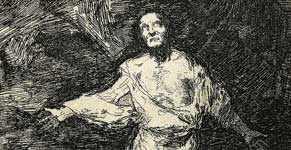The Disasters of War
The crisis of the Antiguo Régimen accelerated in Spain in 1808 with the outbreak of the Peninsular War (1808-1814). This bloody and destructive war was not only a war of Spaniards against the French, but was also an authentic civil war since the patriotas (‘patriots’), meaning most of the Spanish people, fought against the afrancesados (‘Frenchified’), josefinos (‘Josephite’) and infidentes (‘disloyal’) Spaniards who accepted the new monarch José I Bonaparte, imposed by his brother Napoleón as king of Spain.
Goya was a direct witness of that war and its horrors, which he captured in images in The Disasters of War. The series consisted of 80 prints that Goya prepared between 1810 and 1814, coinciding with the prosecution of the war. He worked in secret, for fear of reprisals by the French who occupied Madrid until June 1813. Subsequent political circumstances, including the restoration of absolutism after the return of Ferdinand VII in 1814, blocked their publication, and The Disasters of War were not published until 1863 by the Royal Academy of Fine Arts of San Fernando.
Goya did not exalt military exploits in The Disasters of War, but made a plea against war in general and against violence. It is a bitter, raw and disenchanted reflection on man, immersed in a situation of war that causes cruelty, rape, devastation, death, misery and hunger. It lashes out against the atrocities committed by both sides, French and Spanish. Goya experienced highly dramatic situations that he reflected in his etchings like a reporter or photojournalist today. The Disasters of War demonstrated the failure of reason in which so many of the enlightened classes trusted. It is a chronicle of human failure.
Second edition (1892), Calcografía Nacional.





